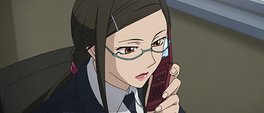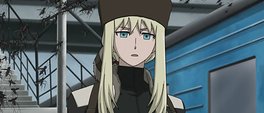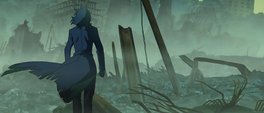



Two minutes and twenty seconds from the start of the first episode until the chirrupy opening and nearly fifteen references to other anime are made, an average of one every ten seconds. Breathless to the point of near schizophrenia, the introduction to Seitokai no Ichizon crams in references to popular websites, itself, fandom, and is almost disparaging of its own existence. Hitting the ground with wheels spinning the first episode is raucous and laugh-out-loud hilarious to the point where one's jaw aches and mind reels with the barrage of anime culture references. That it slows down in the succeeding two episodes is a blessing although the threat of stagnation looms large.
This is poignancy by contrast as is so often the case with comedies
The Hekiyou School Council members are drafted in based on popularity which means the density of "cute" girls is high and the presence of a male all the more shocking - Sugisaki saw an opportunity to go for a harem ending (his words) and dragged his test scores from last to first in order to get an assured seat. The result is a chaotic group that takes pleasure in the act of doing very little while trading barbs and succumbing to their own vices. From the diminutive council leader, Sakurano, with a penchant for rabbit-shaped sweets to the icy cold Akaba with untold mental powers it's an oddball group who's chemistry tends to simmer rather than pop.
Read the rest of this entry




Ignoring the most obvious pussy jokes, Nyan Koi is an unabashed romantic comedy. The opening seconds are rife with familiarity: the sun streaming through classroom windows, a waif-like schoolgirl standing demurely opposite the rag-haired boy. Were it not over in a few seconds the temptation to turn it off in disgust would build to almost unbearable levels. To say the road has been well travelled would be an extreme understatement and all the kitschy hooks in the world aren't enough to save lazy writing and tired character types. Talking cats just don't provide the impetus necessary to last twelve episodes or more, especially when up occupying a genre dominated by heavyweights like the recent Toradora! and similarly veined Kannagi.
with blind faith being put into the local feline mob
The premise concerns Junpei's ability to communicate, Doctor Doolittle style, with cats after a mishap with a local feline shrine. His family's neck-scarf wearing cat speaks of a curse that can only be lifted if he helps one hundred "distressed" cats lest he turn into a cat himself - a fate he is sure would lead to his death given his allergic reaction to cats. This last fact is swiftly forgotten about by the third episode when it becomes obvious the modus operandi of the curse is to introduce and ingratiate Junpei with as many young ladies as is possible. In three episodes his skirt collection is already burgeoning and with a set of twins and an angry looking youth featured in the OP and ED still to come, the pieces are arranged for well-trodden tedium.
Read the rest of this entry




The production of a Queen's Blade anime builds on the fighting-fanservice genre championed by titles such as Ikkitousen and Tenjou Tenge and takes it to the most logical next step. The series, like the "visual combat books" preceding it, is a cynical marketing ploy, a multifaceted brothel catering to every fetish and deviance able to be safely sold to lonely, lewd or lascivious males. Discarding the comparatively coy allusions to naughtiness used in other series, Queen's Blade takes every opportunity to disrobe it's bevy of disproportionately curved females with frequent trips to hot springs, dunkings in hot oil or scattering any other liquid liberally on their persons.
This cavalcade of banality permeates the series from characters to plot
The series is perverse at it's best and represents the most saleable pornography possible: only just restraining itself from full-frontal nudity or explicit sex acts, still hiding behind outlandish situations or judiciously angled shots to retain the microscopic shred of dignity the protagonists may have. Eager not to be branded as cheap smut, there is a certain grotesque inventiveness to just how far character designs and scenes will be taken in order to eke out the most obvious innuendos or exploitive implications.
Please note: the remainder of this post contains images of nudity, if you are offended by these or are otherwise unable to view these images within your municipality due to laws or moral obligations, please do not proceed.
Read the rest of this entry




Darker than Black asked more questions than it reasonably answered so a second season is welcomed not simply for the chance to tie up loose ends. Lamentably, as so far this sequel is as obtuse as the first and omits an overview of the first season in favour of a cryptic flashback, some light romantic drama followed by some out-of-character fan service. The first three episodes present a haggard, visibly scarred Hei with ill-explored traumas inflicted in the intervening period between seasons; an incessantly annoying teenage girl with a flying squirrel sidekick and a selection of Contractors with a variety of outlandish remunerations. So far so Darker than Black.
Russian tundras and snow scattered towns are wonderfully atmospheric
It diverges little in both pace and atmosphere of the first series with the animosity between humans and Contractors still prevalent and mention of a shadowy organisation that seems to exist only to be enigmatic rather than any pragmatic reason. The two episode per story is dropped in favour of a more straightforward linear narrative that sees the teenage girl witness her home destroyed by a number of groups searching for (what else) a meteor fragment; through this she meets Hei and experiences a number of her friends either killed or turned into glassy eyed Contractors. Were it not for the shadow cast by the first season this could well be an intriguing genesis for a new series, there is however an all too present fear that BONES will be miring the already labyrinthine mythos and the conclusion will perhaps give a character but not a story ending.
Read the rest of this entry




It is easy to fall in love with Bakemonogatari when looking at screenshots because for the most part, a collection of screenshots is all you receive with it - the most recent studio SHAFT / Akiyuki Shinbo series. If phrases were associated to anime, Bakemonogatari's would be "style over substance". So far does it take this maxim that it's difficult to describe any point where one feels connected or even mildly interested in the glossy puppets that fornicate with the bold colour palette.
from ice-queen cynicism to obnoxious trollop without missing a step
The story, as much as there is one, concerns Araragi who acts as a paranormal busy body for girls - ranging in age from barely legal to certainly illegal - suffering from a plethora of supernatural ailments. To aid him he regularly consults a destitute punk living in a derelict school with a outwardly pre-teen female vampire. The mythos and character back-stories are the sharpest part of the series and the afflictions suffered by the protagonists are certainly above the usual monster of the week fare, although this is perhaps thanks to the light novel source material than the anime adaptation. SHAFT and Shinbo plot their usual course and drench the series in faux abstract visuals - implying there is more meaning than is available and consequently presenting something vapid and soulless more than modern and engaging. Sudden cuts to single colour title cards start off as eccentric but quickly become a crutch to prop up the wildly varying production.
Read the rest of this entry



















